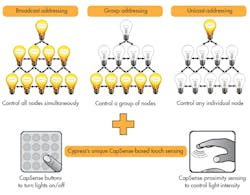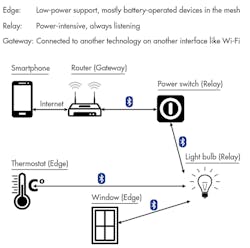Q&A: Going Beyond Point-to-Point Wireless with Bluetooth Smart Mesh
This file type includes high-resolution graphics and schematics when applicable.
Communication between Bluetooth devices used to be limited to a host controller and a set of nearby wireless nodes. Now communication between multiple Bluetooth Smart devices is possible thanks to Smart Mesh. Cypress Semiconductor’s Senior Product Marketing Engineer Utsav Ghosh shares details about this innovative new technology.
Wong: What is Bluetooth Smart Mesh technology?
Ghosh: Smart Mesh is a Bluetooth Profile Specification that defines an interoperable mesh networking solution using Bluetooth Low Energy or Bluetooth Smart. Since its release in June 2010 (as part of Bluetooth 4.0 core specification), Bluetooth Smart has become the technology of choice for the Internet of Things (IoT), including application segments such as home automation, lighting, user-interface devices, and portable medical devices. However, to date, applications using Bluetooth Smart have been limited to short-range, point-to-point or multi-point-to-point (star network) applications that need to connect to a smartphone/tablet or PC.
Smart Mesh seeks to broaden the market serviced by Bluetooth Smart by enabling it to go beyond point-to-point, short-range wireless communication using message relaying across a mesh network (multi-point-to-multi-point). With Smart Mesh, it will be possible to deploy a Bluetooth Smart-based network of lights in your home or a netwofrk of industrial sensors in a manufacturing plant where the complete distance covered by the network exceeds 10 to 30 m. Smart Mesh will enable a true IoT implementation and is expected to increase the Bluetooth Smart market size from approximately 277 million units in 2015 to over 1.2 billion devices in 2020 at a CAGR of 34% (IHS Wireless Tracker 2015).
A few additional points about the Smart Mesh solution:
• It enables a Bluetooth Smart device to communicate with multiple Bluetooth Smart devices.
• It allows message relaying to extend the range of Bluetooth Smart.
• It has built-in security measures to resist known security attacks.
• It can be deployed on any Bluetooth core specification 4.0- or 4.1- or 4.2-compliant IC or module; i.e., it is core specification agnostic (provided the IC or module provider releases a Smart Mesh solution).
Wong: What is the current status of the Smart Mesh implementation standard with Bluetooth SIG?
Ghosh: The Smart Mesh Working Group in Bluetooth SiG is working to finalize the first version of the Smart Mesh Profile Specification by the second quarter of 2016. Developers from almost all major Bluetooth solution providers are part of the Smart Mesh Working Group, and have met multiple times to test their implementations of Smart Mesh for interoperability.
Cypress Semiconductor showcased a demonstration of its Smart Mesh solution at CES 2016 in Las Vegas. The demonstration showed how the Smart Mesh technology could control the brightness of 10 LED bulbs via a CapSense-based proximity sensor (Fig. 1).
Wong: What are some applications where Smart Mesh can be deployed and how can users benefit from the standard?
Ghosh: Smart Mesh has applications across many market segments. Some of the key segments that will immediately benefit from the standard are:
• Home automation: Smart Mesh technology extends the ~10-m typical range of Bluetooth Smart by relaying messages across nodes, allowing your smartphone to communicate with a Bluetooth Smart device from anywhere in your house. Smart Mesh makes it possible to control or receive data on your smartphone from sensors, thermostats, and door locks in any corner of your home.
• Lighting: With Smart Mesh, building and commercial lighting providers will be able to provide affordable wireless controls using Bluetooth Smart. The Smart Mesh profile is expected to have a small memory footprint compared to existing mesh-networking solutions, enabling companies to add mesh networking to their product at a reasonable cost.
• Industrial automation: Machine-to-machine communication between nodes with limited battery capacities in an industrial environment will now be a reality, since Smart Mesh leverages Bluetooth Smart’s ultra-low-power consumption.
Wong: What are the various types of devices in a Smart Mesh solution and how are they configured to retain the low-energy aspect of BLE?
Ghosh: As mentioned, Smart Mesh leverages Bluetooth Smart’s ultra-low-power consumption. To do this, Smart Mesh defines multiple node roles in the mesh network (Fig. 2):
• Relay: Typically a node that is wall-powered and is awake most of the time to receive and relay messages.
• Edge: Typically a battery-powered node that wakes up once in a while to receive and relay messages.
Smart Mesh data packets use the advertisement packet type of Bluetooth Smart. This avoids the creation and maintenance of connections between nodes to enable low-power edge nodes.
Wong: Why does Smart Mesh make sense as a Bluetooth solution compared to other protocols such as ZigBee and Wi-Fi?
Ghosh: Mesh implementations already exist on technologies such as ZigBee, Wi-Fi, and other wireless technologies. Smart Mesh’s advantage over these technologies lies in the fact that Bluetooth Smart is already in your smartphone. This enables you to easily add, remove, and configure nodes using your smartphone and avoid complicated network setup procedures. The ease of use, coupled with Bluetooth Smart’s low power and cost-effectiveness, make Smart Mesh the ideal mesh solution for most applications.
Wong: What other technologies do engineers need to integrate with Smart Mesh solutions to enable successful deployments?
Ghosh: Smart Mesh can easily be deployed as a standalone mesh solution for most applications. In addition, Smart Mesh can coexist with other technologies to allow the mesh to be accessed over the Internet. In these cases, a node will act as a gateway supporting both Bluetooth Smart and Wi-Fi/Ethernet, enabling messages to move from the mesh to the Internet. Other technologies that can be integrated with Smart Mesh include:
• Energy-harvesting technology from renewable sources such as light or heat can be used to power mesh nodes that do not require frequent battery changes. Cypress’s energy-harvesting PMICs represent one solution that has been deployed for beacons and that can easily be extended to Smart Mesh nodes.
• Technologies such as Cypress’s CapSense for touch-sensing- or proximity-sensing-based switches may be used to enhance the user experience and aesthetic appeal of the application.
About the Author
William G. Wong
Senior Content Director - Electronic Design and Microwaves & RF
I am Editor of Electronic Design focusing on embedded, software, and systems. As Senior Content Director, I also manage Microwaves & RF and I work with a great team of editors to provide engineers, programmers, developers and technical managers with interesting and useful articles and videos on a regular basis. Check out our free newsletters to see the latest content.
You can send press releases for new products for possible coverage on the website. I am also interested in receiving contributed articles for publishing on our website. Use our template and send to me along with a signed release form.
Check out my blog, AltEmbedded on Electronic Design, as well as his latest articles on this site that are listed below.
You can visit my social media via these links:
- AltEmbedded on Electronic Design
- Bill Wong on Facebook
- @AltEmbedded on Twitter
- Bill Wong on LinkedIn
I earned a Bachelor of Electrical Engineering at the Georgia Institute of Technology and a Masters in Computer Science from Rutgers University. I still do a bit of programming using everything from C and C++ to Rust and Ada/SPARK. I do a bit of PHP programming for Drupal websites. I have posted a few Drupal modules.
I still get a hand on software and electronic hardware. Some of this can be found on our Kit Close-Up video series. You can also see me on many of our TechXchange Talk videos. I am interested in a range of projects from robotics to artificial intelligence.





